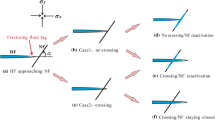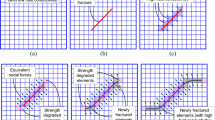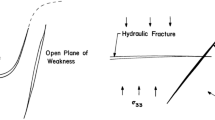Abstract
Hydraulic fracture height containment is a critical issue in the development of unconventional reservoirs. The extent of fracture height growth depends on a variety of factors, particularly stress and stiffness contrasts between adjacent layers. Accurate simulation of fracture growth and containment requires a reliable fracturing criterion. The virtual crack closure technique (VCCT) is a widely used method for computing energy release rate. However, it is based on the assumption that a small crack extension does not significantly alter the state of the crack tip, which is generally not the case when a fracture crosses strong stress and/or stiffness contrasts. In this work, we assess the applicability and accuracy of a modified virtual crack closure technique (MVCCT) for a fluid-driven fracture in breaking through interfaces with significant stress and/or stiffness contrasts, through comparisons with analytical and reference numerical solutions. The results show that significant error could occur when the fracture tip is very near or at stress/stiffness interfaces. However, this error is localized to the interface and proves to be inconsequential to the predicted penetration depth into the rock layer beyond the interface. This study validates the applicability of MVCCT in 3D hydraulic fracturing simulation in strongly heterogeneous rock formations.












Similar content being viewed by others
Abbreviations
- E :
-
Young’s modulus
- G :
-
Energy release rate
- G c :
-
Critical energy release rate
- G I :
-
Energy release rate for Mode I
- K Ic :
-
Critical stress intensity factor for Mode I (known as “fracture toughness”)
- U :
-
Elastic strain energy
- W :
-
Potential energy of the applied loading
- \(\Pi\) :
-
Total potential energy
- ε :
-
Strain tensor
- C :
-
Stiffness matrix
- \(\varvec{b}\) :
-
Body force
- f :
-
Nodal force
- h :
-
Half fracture height
- h 0 :
-
Half thickness of middle-layer or the layer that the fracture is propagating from
- p :
-
Fracture pressure
- \(\hat {{\varvec{t}}}\) :
-
Boundary force
- v :
-
Poisson’s ratio
- w :
-
Fracture width
- σ :
-
In situ stress magnitude
- Δσ :
-
Stress contrast magnitude
References
Abbas SE, Gordeliy AP, Lecampion B, Chuprakov DA, Prioul R (2014) Limited height growth and reduced opening of hydraulic fractures due to fracture offsets: an XFEM application. In: SPE hydraulic fracturing technology conference, 4–6 Feb, The Woodlands. https://doi.org/10.2118/168622-MS
Adachi JI, Detournay E, Peirce AP (2010) Analysis of the classical pseudo-3D model for hydraulic fracture with equilibrium height growth across stress barriers. Int J Rock Mech Min 47(4):625–639. https://doi.org/10.1016/j.ijrmms.2010.03.008
Barree RD (1983) A practical numerical simulator for three-dimensional fracture propagation in heterogeneous media. In: SPE reservoir simulation symposium, 15–18 Nov, San Francisco. https://doi.org/10.2118/12273-MS
Chen Z, Jeffrey RG, Zhang X (2015) Numerical modeling of three-dimensional t-shaped hydraulic fractures in coal seams using a cohesive zone finite element model. Hydraul Frac J 2(2):20–37
Cherepanov GP (1967) The propagation of cracks in a continuous medium. J Appl Math Mech 31(3):503–512. https://doi.org/10.1016/0021-8928(67)90034-2
Chuprakov DA, Prioul R (2015) Hydraulic fracture height containment by weak horizontal interfaces. In: SPE hydraulic fracturing technology conference, 3–5 Feb, The Woodlands. https://doi.org/10.2118/173337-MS
Clifton RJ, Wang JJ (1988) Multiple fluids, proppant transport, and thermal effects in three-dimensional simulation of hydraulic fracturing. In: SPE annual technical conference and exhibition, 2–5 Oct, Houston. https://doi.org/10.2118/18198-MS
Cook TS, Erdogan F (1972) Stresses in bonded materials with a crack perpendicular to the interface. Int J Eng Sci 10(8):677–697. https://doi.org/10.1016/0020-7225(72)90063-8
Cooke ML, Underwood CA (2001) Fracture termination and step-over at bedding interfaces due to frictional slip and interface opening. J Struct Geol 23(2):223–238. https://doi.org/10.1016/S0191-8141(00)00092-4
Daneshy AA (1978) Hydraulic fracture propagation in layered formations. SPE J. https://doi.org/10.2118/6088-PA
Delaney PT, Pollard DD, Ziony JI, McKee EH (1986) Field relations between dikes and joints: emplacement processes and palesostress analysis. J Geophys Res 91(B5):4920–4938. https://doi.org/10.1029/JB091iB05p04920
Fisher MK, Warpinski NR (2012) Hydraulic fracture-height growth: real data. SPE Prod Oper. https://doi.org/10.2118/145949-PA
Fu P, Johnson SM, Settgast RR, Carrigan CR (2012) Generalized displacement correlation method for estimating stress intensity factors. Eng Fract Mech 88:90–107. https://doi.org/10.1016/j.engfracmech.2012.04.010
Fung RL, Vijayakumar S, Cormack D (1987) Calculation of vertical fracture containment in layered formations. SPE Form Eval 2(4):518–522. https://doi.org/10.2118/14707-PA
Gu H, Siebrits E (2008) Effect of formation modulus contrast on hydraulic fracture height containment. SPE Prod Oper. https://doi.org/10.2118/103822-PA
Hanson ME, Shaffer RJ (1980) Some results from continuum mechanics analyses of the hydraulic fracturing process. SPE J. https://doi.org/10.2118/7942-PA
Hilton PD, Sih GC (1971) A laminate composite with a crack normal to the interfaces. Int J Solids Struct 7(8):913–930. https://doi.org/10.1016/0020-7683(71)90072-2
Hsiao C, El Rabaa AW (1987) Fracture toughness testing of rock cores. In: The 28th U.S. symposium on rock mechanics, 29 Jun–1 Jul, Tucson. ARMA 87-0141
Huang J, Morris J, Fu P, Settgast RR, Sherman CS, Ryerson FJ (2018) Hydraulic fracture height growth under the combined influence of stress barriers and natural fractures. SPE J. https://doi.org/10.2118/189861-PA
Hutchinson JW, Suo Z (1991) Mixed mode cracking in layered materials. Adv Appl Mech 29:63–191. https://doi.org/10.1016/S0065-2156(08)70164-9
Irwin GR (1957) Analysis of stresses and strains near the end of a crack traversing a plate. J Appl Mech 24:361–364
Krueger R (2014) Virtual crack closure technique: history, approach, and applications. Appl Mech Rev 57(2):109–143. https://doi.org/10.1115/1.1595677
Lam KY, Cleary MP (1984) Slippage and re-initiation of (hydraulic) fractures at frictional interfaces. Int J Numer Anal Met 8(6):589–604. https://doi.org/10.1002/nag.1610080607
Leguillon D, Lacroix C, Martin E (2000) Interface debonding ahead of a primary crack. J Mech Phys Solids 48(10):2137–2161. https://doi.org/10.1016/S0022-5096(99)00101-5
Leski A (2007) Implementation of the virtual crack closure technique in engineering FE calculations. Finite Elem Anal Des 43(3):261–268. https://doi.org/10.1016/j.finel.2006.10.004
Li FZ, Shih CF, Needleman A (1985) A comparison of methods for calculating energy release rates. Eng Frac Mech 21(2):405–421. https://doi.org/10.1016/0013-7944(85)90029-3
Li H, Zou Y, Valko PP, Ehlig-Economides C (2016) Hydraulic fracture height predictions in laminated shale formations using finite element discrete element method. In: SPE hydraulic fracturing technology conference, 9–11 Feb, The Woodlands. https://doi.org/10.2118/179129-MS
Liu S, Valko PP (2017) A rigorous hydraulic-fracture equilibrium-height model for multilayer formations. SPE Prod Oper. https://doi.org/10.2118/173335-PA
Mader D (1989) Hydraulic proppant fracturing and gravel packing, 1st edn. Elsevier Science Ltd, Burlington
Maxwell SC (2011) Hydraulic fracture height growth. CSEG Rec 36(9):19–22
McClure MW, Horne R (2013) Discrete fracture network modeling of hydraulic stimulation: coupling flow and geomechanics. In: Springer briefs in earth sciences. Springer. https://doi.org/10.1007/978-3-319-00383-2
Nolte KG, Smith MG (1981) Interpretation of fracturing pressures. J Pet Technol 33(9):1767–1775. https://doi.org/10.2118/8297-PA
Palmer ID, Luiskutty CT (1985) A model of the hydraulic fracturing process for elongated vertical fractures and comparisons of results with other models. In: SPE/DOE low permeability gas reservoirs symposium, 19–22 May, Denver. https://doi.org/10.2118/13864-MS
Palmer ID, Sparks DP (1991) Measurement of induced fractures by downhole tv camera in black warrior basin coalbeds. J Pet Technol. https://doi.org/10.2118/20660-PA
Parks DM (1974) A stiffness derivative finite element technique for determination of crack tip stress intensity factors. Int J Fract 10:487. https://doi.org/10.1007/BF00155252
Perkins TK, Kern LR (1961) Widths of hydraulic fractures. J Pet Technol 13(9):937–949. https://doi.org/10.2118/89-PA
Raju IS (1987) Calculation of strain-energy release rates with higher order and singular finite elements. Eng Fract Mech 28(3):251–274. https://doi.org/10.1016/0013-7944(87)90220-7
Rice JR (1968) A path independent integral and the approximate analysis of strain concentration by notches and cracks. J Appl Mech 35:379–386
Rybicki EF, Kanninen MF (1977) A finite element calculation of stress intensity factors by a modified crack closure integral. Eng Fract Mech 9(4):931–938. https://doi.org/10.1016/0013-7944(77)90013-3
Scholz CH (2010) A note on the scaling relations for opening mode fractures in rock. J Struct Geol 32:1485–1487. https://doi.org/10.1016/j.jsg.2010.09.007
Settgast R, Fu P, Walsh S, White J, Annavarapu C, Ryerson F (2017) A fully coupled method for massively parallel simulation of hydraulically driven fractures in 3-dimensions. Int J Numer Anal Method Geomech 41(5):627–653. https://doi.org/10.1002/nag.2557
Sheibani F, Olson JE (2013) Impact of fracture height on mixed mode fracture propagation: insights from 3d displacement discontinuity modeling. In: 47th U.S. rock mechanics/geomechanics symposium, 23–26 Jun, San Francisco. ARMA 13-596
Shivakumar KN, Tan PW, Newman JC (1988) A virtual crack-closure technique for calculating stress intensity factors for cracked three dimensional bodies. Int J Fract 36:43–50
Shlyapobersky J, Issa MA et al (1998) Scale effects on fracture growth resistance in poroelastic media. In: SPE annual technical conference and exhibition, 27–30 Sep, New Orleans. https://doi.org/10.2118/48929-MS
Simonson ER, Abou-Sayed AS, Clifton RJ (1978) Containment of massive hydraulic fractures. SPE J 18(1):27–32. https://doi.org/10.2118/6089-PA
Smith MB, Bale AB, Britt LK, Klein HH, Siebrits E, Dang X (2001) Layered modulus effects on fracture propagation, proppant placement, and fracture modeling. In: SPE annual technical conference and exhibition, 30 Sep–3 Oct, New Orleans. https://doi.org/10.2118/71654-MS
Tada H, Paris P, Irwin G (2000) The stress analysis of cracks handbook, 3er edn. Wiley-Blackwell, Hoboken. https://doi.org/10.1115/1.801535
Teufel LW, Clark JA (1984) Hydraulic fracture propagation in layered rock: experimental studies of fracture containment. SPE J. https://doi.org/10.2118/9878-PA
Thiercelin M, Jeffrey RG, Naceur KB (1989) Influence of fracture toughness on the geometry of hydraulic fractures. SPE Prod Eng 4(4):435–442. https://doi.org/10.2118/16431-PA
Tracey DM (1971) Finite elements for determination of crack tip elastic stress intensity factors. Eng Fract Mech 3(3):255–265. https://doi.org/10.1016/0013-7944(71)90036-1
Van Eekelen HAM (1982) Hydraulic fracture geometry: fracture containment in layered formations. SPE J. https://doi.org/10.2118/9261-PA
Voegele MD, Abou-Sayed AS, Jones AH (1983) Optimization of stimulation design through the use of in situ stress determination. J Pet Technol 35(6):1071–1081. https://doi.org/10.2118/10308-PA
Warpinski NR, Schmidt RA, Northrop DA (1982a) In situ stresses: the predominant influence on hydraulic fracture containment. J Pet Technol 34(3):653–664. https://doi.org/10.2118/8932-PA
Warpinski NR, Clark JA, Schmidt RA, Huddle CW (1982b) Laboratory investigation on the effect of in situ stresses on hydraulic fracture containment. SPE J. https://doi.org/10.2118/9834-PA
Warpinski NR, Branagan PT, Peterson RE, Wolhart SL (1998) An interpretation of m-site hydraulic fracture diagnostic results. In: SPE rocky mountain regional/low-permeability reservoirs symposium, 5–8 April, Denver. https://doi.org/10.2118/39950-MS
Weng X, Kresse O, Cohen C, Wu R, Gu H (2011) Modeling of hydraulic-fracture-network propagation in a naturally fractured formation. SPE Prod Oper. https://doi.org/10.2118/140253-PA
Wright CA, Weijers L, Davis EJ, Mayerhofer M (1999) Understanding hydraulic fracture growth: tricky but not hopeless. In: SPE annual technical conference and exhibition, 3–6 October, Houston. https://doi.org/10.2118/56724-MS
Wu K, Olson JE (2015) Simultaneous multifracture treatments: fully coupled fluid flow and fracture mechanics for horizontal wells. SPE J. https://doi.org/10.2118/167626-PA
Xie D, Biggers SB Jr (2006) Progressive crack growth analysis using interface element based on the virtual crack closure technique. Finite Elem Anal Des 42:977–984. https://doi.org/10.1016/j.finel.2006.03.007
Zhang X, Jeffrey RG (2008) Reinitiation and termination of fluid-driven fractures at frictional bedding interfaces. J Geophys Res Atmos 113:B08416. https://doi.org/10.1029/2007JB005327
Zhang X, Wu B, Jeffrey RG, Connell LD, Zhang G (2017) A pseudo-3d model for hydraulic fracture growth in a layered rock. Int J Solids Struct 115–116:208–223. https://doi.org/10.1016/j.ijsolstr.2017.03.022
Zhou J, Huang H, Deo M (2016) Simulation of hydraulic and natural fracture interaction using a coupled DFN-DEM model. In: 50th US rock mechanics/geomechanics symposium, 26–29 Jun. ARMA 16-739
Zhou J, Huang H, McLennan J, Meakin P, Deo M (2017) A dual-lattice discrete element model to understand hydraulic fracturing in a naturally fractured system. Hydraul Fract J 4(2):66–82
Acknowledgements
This manuscript has been authored by Lawrence Livermore National Security, LLC under Contract no. DE-AC52-07NA27344 with the US. Department of Energy. The United States Government retains, and the publisher, by accepting the article for publication, acknowledges that the United States Government retains a non-exclusive, paid-up, irrevocable, world-wide license to publish or reproduce the published form of this manuscript, or allow others to do so, for United States Government purposes. This document is LLNL report LLNL-JRNL-751676.
Author information
Authors and Affiliations
Corresponding author
Additional information
Publisher’s Note
Springer Nature remains neutral with regard to jurisdictional claims in published maps and institutional affiliations.
Rights and permissions
About this article
Cite this article
Huang, J., Fu, P., Settgast, R.R. et al. Evaluating a Simple Fracturing Criterion for a Hydraulic Fracture Crossing Stress and Stiffness Contrasts. Rock Mech Rock Eng 52, 1657–1670 (2019). https://doi.org/10.1007/s00603-018-1679-7
Received:
Accepted:
Published:
Issue Date:
DOI: https://doi.org/10.1007/s00603-018-1679-7




